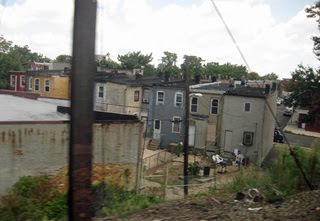read this article this morning from an older issue of the New York Times entitled, A Plan to Spur Growth Away From Haiti’s Capital . This article talks about a plan that was unveiled a few months ago that will rebuild Haiti by decentralizing its urban core through land use practices designed to create smaller urban and rural cores.
Based upon my American planning knowledge, the first thing I thought was how backwards does this sound? Decentralizing the city? American cities are on a rapid decline; populations in the city are decreasing while suburban populations are increasing. In Haiti, the expected growth for Port-au-Prince is targeted to hit 6,000,000 in the next 15 years. The population is expected to double from its 3,000,000 inhabitants now.
Upon further investigation, this plan is in fact very fitting giving the condition of the country and the surrounding environmental concerns:
Prepared by a group of urban planners from the Haitian government agency responsible for the country’s development, the plan is built around a bold central idea: to redistribute large parts of the population of Port-au-Prince to smaller Haitian cities, many of them at a safe distance from areas most vulnerable to natural disaster. In the process the plan would completely transform Haiti from a country dominated by a single metropolis to what the planners call a network of smaller urban “growth poles.”
As part of this plan come an array of new zoning and land-use regulations that will transform the capitol and the country, plans for a light rail system, a waterfront park in Port-au-Prince, and smaller public spaces throughout the region.
As with most plans, these ideas are great but the crucial component will be finding funding and political support in a country that is still on its knees six months later.
Tuesday, July 20, 2010
Monday, July 19, 2010
Minorities in Architecture and Planning
America has made great strides in equality in this country. We have more minorities than ever employed in fields that were traditionally segregated. We have more minorities in top positions in Fortune 500 companies. We even have a minority president. But does this mean that we have reached that ideal level of equality?
In the article, Blacklisted: Is failing to plan with minority architects, in fact, planning to fail?, the author discusses the lack of representation of minorities in the architecture, planning, and landscape architecture related fields. Even though it makes sense to have minority planners and developers represent their own communities that is not what is happening. Planning can be very political in nature and because of that, there exist certain barriers that are harder to overcome.
Minorities in these professions have to prove themselves worthy before they can become successful professionals. Students who attend HBCUs are faced with a different set of problems. Lack of resources, lack of professional guidance, lack of modern equipment and a host of others are all problems that are guaranteed to arise during a student's academic career at an HBCU. Tuskegee University, a program founded on the belief that architectural mastery can combat oppression, lost its accreditation.
The battle is a continuous battle to fight for architectural, planning, and development equality if there isn't a loud enough, and skilled enough collective voice within these communities.
Transferring from an HBCU Graduate Program in CREP, I experienced these same flaws and shortcomings in my program. I transferred to another institution and have seen a remarkable difference in the quality of resources given to us to work with.
My thoughts: Before we can adequately address the discrepancies in minority communities, we should address the educational foundation that is being laid for the profession.
In the article, Blacklisted: Is failing to plan with minority architects, in fact, planning to fail?, the author discusses the lack of representation of minorities in the architecture, planning, and landscape architecture related fields. Even though it makes sense to have minority planners and developers represent their own communities that is not what is happening. Planning can be very political in nature and because of that, there exist certain barriers that are harder to overcome.
Minorities in these professions have to prove themselves worthy before they can become successful professionals. Students who attend HBCUs are faced with a different set of problems. Lack of resources, lack of professional guidance, lack of modern equipment and a host of others are all problems that are guaranteed to arise during a student's academic career at an HBCU. Tuskegee University, a program founded on the belief that architectural mastery can combat oppression, lost its accreditation.
The battle is a continuous battle to fight for architectural, planning, and development equality if there isn't a loud enough, and skilled enough collective voice within these communities.
Transferring from an HBCU Graduate Program in CREP, I experienced these same flaws and shortcomings in my program. I transferred to another institution and have seen a remarkable difference in the quality of resources given to us to work with.
My thoughts: Before we can adequately address the discrepancies in minority communities, we should address the educational foundation that is being laid for the profession.
Wednesday, July 14, 2010
Urban Decay.....How do we handle it?
Let's chat about Urban Decay for a minute... and no I'm not reffering to the pretty eyeshadows you can buy at Sephora
+What is Urban Decay: the process whereby a previously functioning city, or part of a city, falls into disrepair and decrepitude. It may feature deindustrialization, depopulation or changing population, economic restructuring, abandoned buildings, high local unemployment, fragmented families, political disenfranchisement, crime, and a desolate, inhospitable city landscape.
Does this sound like a familar place to you?
+What is Urban Decay: the process whereby a previously functioning city, or part of a city, falls into disrepair and decrepitude. It may feature deindustrialization, depopulation or changing population, economic restructuring, abandoned buildings, high local unemployment, fragmented families, political disenfranchisement, crime, and a desolate, inhospitable city landscape.
Does this sound like a familar place to you?
Baltimore, once a thriving port city off of the Chesapeake Bay faced a decline after its period of deindustrialization. Once the second largest city in the nation with close to one million persons, this city now has around 650,00 residents. The mass exodus has left us with some visual examples of urban decay:
Abandoned rowhomes, abandoned and boarded up city blocks, garbage filled lots...These are the marks of Baltimore's City Urban Decay
Just about eery major city has some form of Urban Decay: Cleveland, Detroit, Chicago, New York, Miami, Tampa, Washington DC, Philadelphia, Los Angeles, Tampa, Dallas, and the list goes on and on.
The sad thing about Urban Decay is that many of these areas were once thriving communities with middle/working class citizens. The decisions of city and local officials in the planning department, highway construction, economic recessions, massive job layoffs, plant and industrial facility closures, sprawl and suburbanization, and crime are all contributing to factors to Urban Decay.
Until these areas are revitalized and redeveloped, how do we handle the linger populations in these areas? How do we ensure that despite their surroundings that they still have the same opportunities and resources as those in suburbia? How do we ensure that the children growing up still recieve a quality education? How do we ensure that the psychological effects of growing up in these conditions are addressed?
Is demolishing these areas to the ground and relocating the residence a viable solution? Is a redevelopment strategy that will change these areas to bustling commercial/retail/residential/mixed-use corridors the best option?What happends when these who live here are displaced?
Just because you change the facade and appearance of urban decay with trendy architecture and innovative planning strategies doesn't mean that we have addressed the sociological and mental issues assosciated with decay....
Your thoughts???
Oil Spill... Poor Planning is the blame?
100 days. We are nearing 100 days of this oil-spill crisis. First it was BP's fault, then it was the government's fault, then it was Obama's fault, now its the fault of City Planning. I recently read a post on Planetizen and Vishaan Chakrabarti claims that sprawl has encouraged a reliance on oil, which in turn has created this tragedy. Pause....Rewind....
I agree that sprawl has contributed to negative land-use and sustainability practices in recent decades but is it a fair assesment to say that this oil spill tragedy and poor planning practices are related?
Vishaan Chakrabarti states: "Do we have the vision to recognize that we have seen the enemy, and it is the suburban house? Do we have the will to embrace high-density living as the only solution, the only land use that limits our energy use, our healthcare costs, our vulnerability to petro-dictators, and our free fall into a sprawling national deficit?"
The enemy according to Chakrabarti is the suburban house... He believes that the suburban house is now the root of all evil and its downfall is of course the only way to fix our national state of affairs.
Is his point valid? or he is extrapolating these issues on planners just to mask the larger issue(s) at hand?
I agree that sprawl has contributed to negative land-use and sustainability practices in recent decades but is it a fair assesment to say that this oil spill tragedy and poor planning practices are related?
Vishaan Chakrabarti states: "Do we have the vision to recognize that we have seen the enemy, and it is the suburban house? Do we have the will to embrace high-density living as the only solution, the only land use that limits our energy use, our healthcare costs, our vulnerability to petro-dictators, and our free fall into a sprawling national deficit?"
The enemy according to Chakrabarti is the suburban house... He believes that the suburban house is now the root of all evil and its downfall is of course the only way to fix our national state of affairs.
Is his point valid? or he is extrapolating these issues on planners just to mask the larger issue(s) at hand?
Subscribe to:
Comments (Atom)





